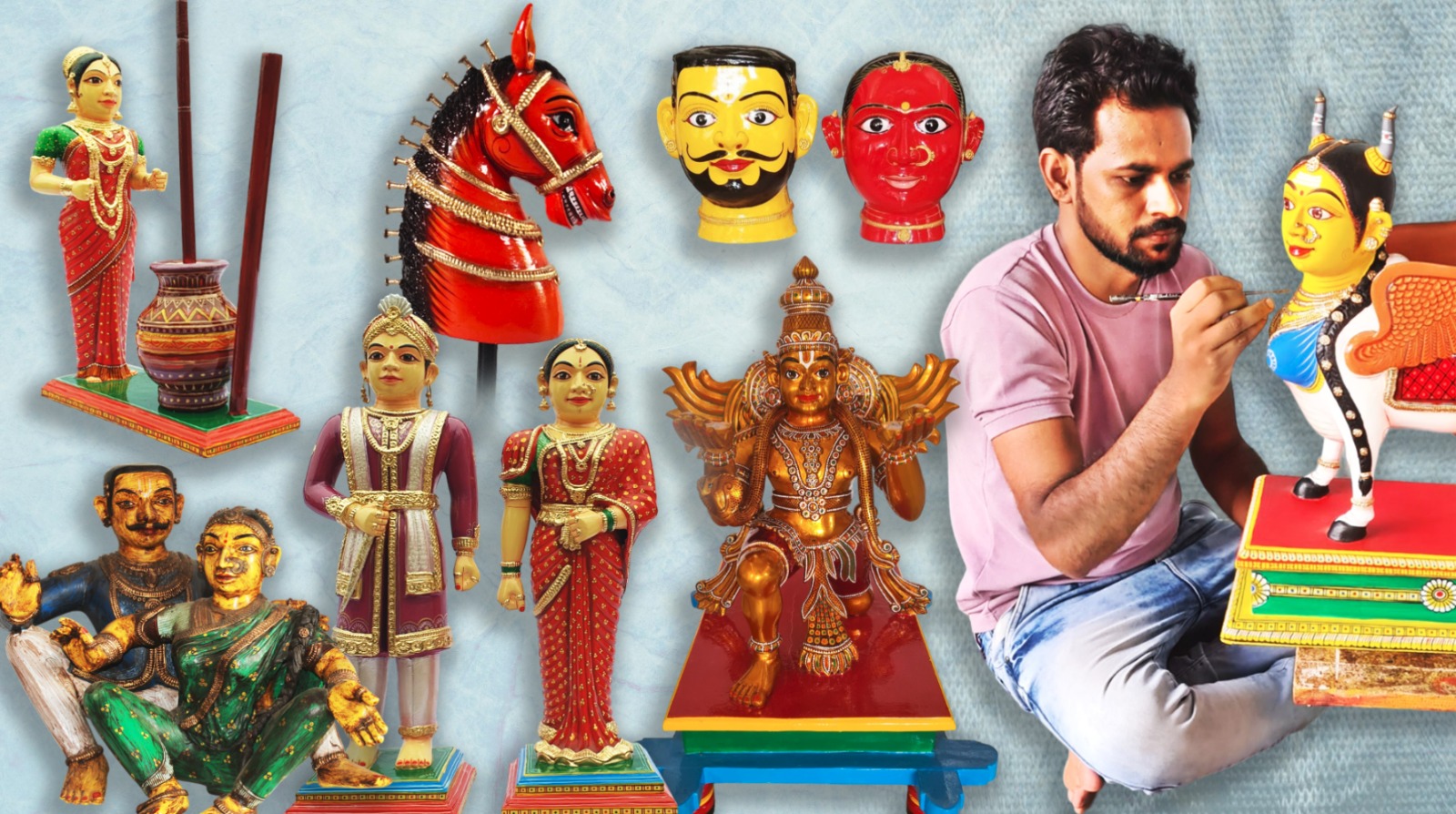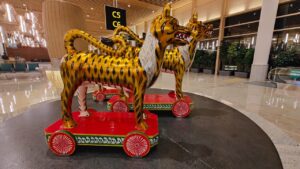Kinnal — or Kinhal — craft is a form of sculpting wood and it has a history that dates back to the Vijayanagara Empire. Historians speculate that when the Vijayanagara empire fell to invaders, the vast community of artisans, who carved the images of the Hampi temple complex, scattered, affecting the craft.
Published Sep 22, 2024 | 9:00 AM ⚊ Updated Sep 22, 2024 | 1:13 PM

Santosh Kumar Anjaneya Chitragar, Kinnal Artist (South First)
Santosh Kumar Anjaneya Chitragar, a 32-year-old Kinnal artist, carries the legacy of a centuries-old craft that takes its name from Kinnal village in Karnataka’s Koppal district.
Kinnal — or Kinhal — craft is a form of sculpting wood and it has a history that dates back to the Vijayanagara Empire. Historians speculate that when the Vijayanagara empire fell to invaders, the vast community of artisans, who carved the images of the Hampi temple complex, scattered, affecting the craft.
Among those artisans were the first Kinnal artisans; their descendants have carried on the tradition of crafting images in wood, used for worship. Over the years, however, the popularity of this craft has dwindled, and artisans like Santosh have struggled to keep the tradition alive.
Santosh was born into a family of Chitragars (painters and sculptors). “It’s muscle memory,” he says, recalling how he grew up watching his grandparents and parents create idols, particularly for temples.
For years, his family barely survived on the few orders they received, often making only two or three idols annually. As demand for the idols faded, his parents faced financial hardship, like many others who followed the craft in Kinnal.
Of the 67 families traditionally involved in Kinnal art, only 25-30 remain today. Many former artisans now work as house painters or in garages to make ends meet.
Kinnal art’s uniqueness lies in its intricate process. Artisans carve lightweight wood intricately, then apply a mixture of neem powder, tamarind seed powder, and jute to shape the figures.
This mixture, called “kitta,” creates smooth, rounded edges, differentiating Kinnal art from other forms of sculpture. The process involves layering the figures with cotton soaked in tamarind paste before applying pebble paste, which acts as the base for painting.

Kinnal art’s unique blend of wood carving and natural powders gives life to round-edged, intricate designs. (Supplied)
Traditionally, Kinnal idols depicted mythological figures such as Rama, Lakshmana, Sita, and Durga Devi, primarily for temples.
Santosh, armed with a fine arts degree, set about extending this craft to interior decor, transforming his family’s traditional business.
When Santosh initially ventured into the world of home decor, he faced an obstacle: People were hesitant to buy religious idols for their homes, fearing it would be disrespectful to deities.
Santosh adapted by altering the colour schemes and tones, particularly with the Gauri idols. He highlighted the serene beauty of Gauri’s face, which resonated well with buyers looking for a spiritual yet artistic touch for their homes.
Santosh’s journey from a struggling artisan to a successful entrepreneur began on social media. His first order came six months after posting pictures of his work on Instagram, leading to what he calls a “golden charm” moment. Since then, Instagram has been his primary platform for showcasing his art, and his business has grown significantly.
One of Santosh’s most significant achievements was securing a project for Bengaluru International Airport’s Terminal 2. Through his collaborations with galleries like Gallery G, Santosh submitted his designs, including a Gandharva (mythological demigod, depicted as dancer or performer).
The Gandharva symbolised the airport’s function, representing the concept of flight. However, Santosh had to make creative adjustments, such as replacing the crown to avoid any religious connotations, in keeping with the airport’s secular ethos.
Despite the project’s scale, Santosh kept it a secret from his family, fearing that they would be alarmed for him and overwhelm him. When the project was completed, however, a documentary crew visited his home and the cat was out of the bag. His family glowed with pride at his achievement.
Santosh’s business has expanded to producing custom-made interior decoration pieces and partnering with brands like Dalmia Cement, for whom he is currently crafting 470 Gauri idols.

Each Kinnal sculpture is hand-finished with a meticulous application of natural dyes and pebble powder. (Supplied)
He leads a team of 10 artisans, each specialising in different aspects of the production process, from wood carving to the application of the kitta and painting. He also provides opportunities for local artisans, subcontracting parts of larger projects to help sustain the craft within his community.
His use of natural dyes and a family-developed colour called “Lajjavar” adds a distinctive touch to his creations. Lajjavar, a secret family formula, is painstakingly prepared by hand, contributing to the uniqueness of his work.
Santosh points out that even though machine processes are faster, they lack the subtle hues and quality that come from traditional hand-preparation methods.
Santosh dreams of building a larger workshop where his artisans can work comfortably and expand production. Currently, most of his orders come through Instagram, and while he does not yet have a physical store, his focus remains on quality and timely delivery. He also conducts workshops to pass on his skills to the next generation, ensuring the craft endures.
Santosh says he too feels the challenges faced by traditional artisans, from the physical toll of long hours preparing materials to the economic struggles that come with a niche market. He hopes for more government support, so Kinnal art continues to thrive.
(Edited by Rosamma Thomas)
